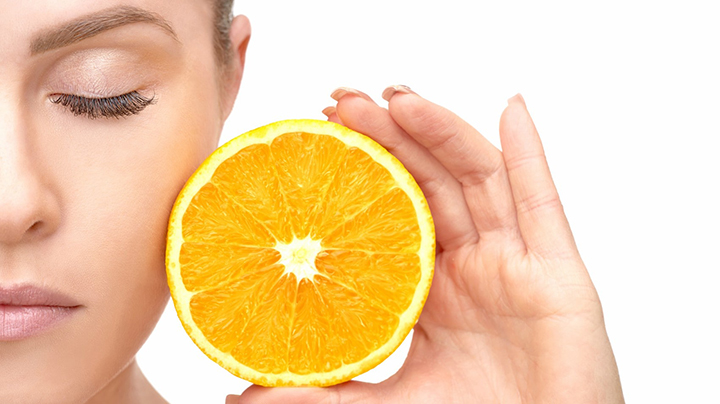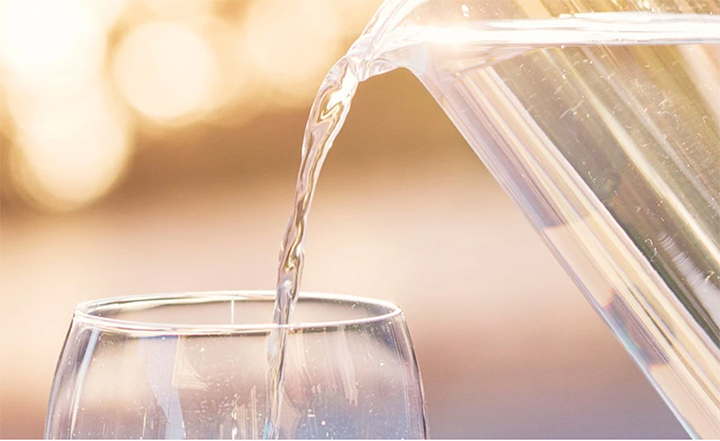Diet for radiant skin

Why is healthy and radiant skin one of the most popular goals for men and women, but also the most difficult one to achieve?
Some simply consider it a barrier that separates the body from the external world, others see it as the mirror of the soul. One thing is for sure: our skin is the part of our body that is most visible to others, which is why it is under constant pressure and scrutiny. This is sufficient when observing this organ with highly versatile functions, to gain an in-depth understanding of its structure.
Skin is a continuous fabric that is part of the integumentary system and consists of three main layers: the outermost one is the epidermis, followed by the derma and the innermost one, the hypodermis (or subcutaneous layer).

It carries out numerous and highly important functions: it protects us from injuries, ultraviolet radiation, microorganisms and chemical agents; it prevents the loss of liquids; it is involved in the heat regulation mechanism, together with sweat glands, while also regulating blood flow; it coordinates the immune response against tumours and other pathogenic agents; it is involved in sensory function and is also an important fat store.
Lastly, skin also has metabolic properties, as vitamin D occurs at a cutaneous level.
Well hydrated skin with closed pores, visible vessels or otherwise, youthful in appearance and naturally radiant, uniform face colour: all this depends on skin quality.
The epidermal matrix (basal membrane) adheres to skin (derma) by means of cylindrical shaped cells and the aim is the make the bond between the epidermis and dermis as strong as possible.
The stronger the structure of the derma, or connective tissues, the more toned and resistant skin is.
Its health is conditioned by genetic factors and the natural ageing process, as well as acquired factors, such as the amount and duration of exposure to sun, wind, cold, environmental pollution, smoking, unsuitable cosmetic treatments, unbalanced diet, insufficient hydration and stress, which all contribute towards the degradation of this connective tissue cushion.
The consequences are clearly visible on the surface. Therefore, my recommendation is to care for your skin and nurture your body as a whole, by adopting a lifestyle with particular focus on:
- Diet;
- Physical activity;
- Water intake;
- Sleep;
- Exposure to sun;
- Smoking;
- Alcohol.
There is frequent mention of "free radicals" and of how damaging they are to skin cells (oxidative stress) as well as collagen and elastin, resulting in a loss of elasticity, connective tissue collapse, the formation of wrinkles and ageing.
It is an entirely natural process and part of life, however we can help our body to defend itself from free radicals through anti-oxidative systems and by not making things even more difficult for it.
A diet with food rich in antioxidants:

Vitamin C
It is the antioxidant present in the highest concentrations in our body. It plays a fundamental role in growth and tissue repair, a protective action against the effects of atmospheric pollution and photo-oxidation due to UV rays and is also involved in collagen synthesis.
The most vitamin C rich foods are: kiwis, strawberries, citrus fruits, melons, yellow and red peppers, green leaved vegetables like asparagus, broccoli, tomatoes, spinach, basil and aromatic herbs.
Vitamin A
A powerful antioxidant that encourages the synthesis of skin compounds.
It can be found in eggs, milk and derivatives and in liver, whereas beta-carotene, a precursor, is present in yellow-orange and green leaved vegetables (carrots, pumpkin, melon, broccoli, spinach, peppers, oranges, apricots).
Vitamin E
A vitamin that fights against free radicals and protects essential fatty acids and vitamin A from oxidation. The food richest in this vitamin, something no diet should ever be without, is extra virgin olive oil. Since ancient times it has always had the power to soothe reddening, prevent chapping and fight skin ageing. Other foods rich in this vitamin include wheat germ, nuts and whole wheat bread.
Water
In addition to warding off free radicals, correct nutrition that prevents premature skin ageing should also ensure good hydration.
In general, the recommended daily water intake for those without any health problems is at least 2 litres of liquids in the form of beverages, which together with fresh fruits and vegetables, help prevent dry and scaly skin.

Minerals
Micronutrients are also important for skin health. Potassium, Selenium and Zinc are especially important in the synthesis of fibres contained in subcutaneous tissue, making skin elastic and firm. Eating fruits and vegetables on a daily basis, varying the colour of vegetables several times during the week, guarantees a necessary intake of vitamins and mineral salts.
Fresh seasonal vegetables are crucial because preservation or forced cultivations impoverish nutritional properties; moreover, the variety of vegetables means that all nutrients are included in your diet.
Cabbage, broccoli, cauliflower and pulses rich in plant proteins, vitamins, fibres and potassium.
B group vitamins, which encourage skin and mucosa cell renewal. Unrefined grains, milk, meat, fish, fresh vegetables and nuts are rich in these vitamins.
Omega 3, essential polyunsaturated fatty acids, are present in cell membranes.
Fish are particularly rich in them, especially oily fish like mackerel, sardines, anchovies, salmon, and nuts, such as walnuts.
Lifestyle
Apart from causing damage to the body and generally resulting in profound dehydration, alcohol abuse also produces free radicals and rapid ageing, not just of the skin but of the entire body.
The most effective remedy is to drink no more than a glass of wine per day for women and 2 for men, and to steer clear of spirits.
Smoking, in addition to causing a dull appearance and lack of radiance, also speeds up the formation of wrinkles.
Smoking produces free radicals, vasoconstriction, which can modify connective tissue, elastin and collagen.
Sedentariness, the absence of regular physical exercise, aerobic in particular, limits vascularisation and the formation of capillaries, thus reducing nourishment to the outermost part of our body: our skin.
A good diet is far less effective if you are sedentary; your skin will be more beautiful and healthier if you engage in physical activity.
Good aerobic physical activity must consist of at least 150 minutes per week with daily sessions of 30 minutes or longer.
Early skin ageing takes place gradually and it is difficult to notice damaged skin from one day to the next.
This is why you should prevent already at a young age, with an awareness of how not only your skin, but you entire body, will benefit from it. And why not, starting from our table?
WHAT TO WEAR
• Additional help can come in the form of garments that improve skin hydration and elasticity during the day (see functional slimming leggings or activewear) and at night (see draining pyjama), without forgetting about facial skincare (see Beauty-Pack).

